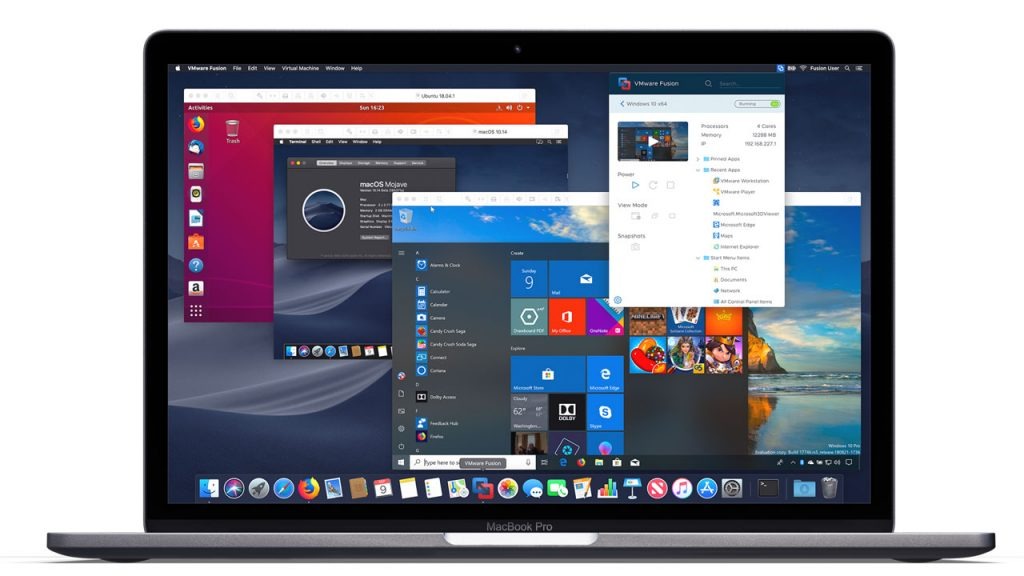Vmware Fusion Run Apps Natively In Mac
- Vmware Run Mac On Windows
- Vmware Fusion Run Apps Natively In Mac Download
- Vmware Fusion Run Windows Applications On Mac
VMware Fusion can run any of hundreds of operating systems provided by the user, including many older versions of macOS, which gives users a way to run older Mac application software that can no longer be run under the current version of macOS, such as 32-bit apps and Rosetta apps. VMware Fusion delivers a secure and powerful desktop sandbox for running Windows or other operating systems on the Mac without rebooting. Use at home to run Windows DX11 games or for learning with a Personal License, or use Fusion Player to separate Work from Home life with a commercial license.
On my current project, it’s necessary to host a Windows virtual machine from my MacBook Pro using VMware Fusion. This can sometimes result in a frustrating and slow development process. Out of the box:
- I found myself unable to use my window manager to move and resize windows as I would’ve liked,
- I experienced window flickering from the guest OS,
- I was unable to share files between the 2 operating systems, and
- I didn’t have a shared paste buffer.
Overall, I found the integration between the two less than seamless and pretty painful. Over the past couple of months, I’ve picked up a couple of tricks to make the experience less frustrating.
1. Consider which View Mode to Use
Vmware offers 3 options to run the guest operating system. After some experimentation, I prefer unity mode. To try unity mode, while the guest OS is running, use shift + cmd + u. Once in unity mode, you can use that same shortcut to toggle it back off. You can also find this option in the VMware Utilities menu under View => Unity.
Unity mode has worked well for me for several reasons. First, it makes the virtualized apps look like they are running more like native apps. Practically, this means that you can use command+tab to toggle through them like a Mac app. And you can use command instead of control for simple shortcuts like copy/paste.
Additionally, running in unity mode allows you to have the windows of the guest operating system on more than one display. While these are small benefits, they save me a lot of time and frustration throughout the day.
2. Add Windows Apps to the Mac Applications Folder
Adding windows apps to the host’s applications folder will allow you to use spotlight search (cmd + space) to open them.
Run Windows 3D applications that require DirectX 9.0c with Shader Model 3, or OpenGL 2.1, on your Mac. Import virtual machines created with Parallels Desktop or Microsoft Virtual PC for Mac. Migrate your physical Windows PC to a VMware Fusion virtual machine with the integrated Migration Assistant. VMware Fusion lets you run more than 200 operating systems as virtual machines. Nearly all programs that run natively on these operating systems will run within VMware Fusion. Apps can range from widely used productivity suites (for example Microsoft Office) to graphics-intensive programs such as AutoCAD or SolidWorks, and much more.
You can even add guest apps to the Mac applications folder. This makes it much easier to open apps quickly like a new windows PowerShell window or other windows app.
3. Set Up a Clear Folder Sharing Structure
Vmware Run Mac On Windows

The firm has not looked back since. First, VMware’s Fusion Pro satisfied their Dynamics needs, allowing each of the users to create a dual-screen desktop environment of both MacOS and Windows, running applications simultaneously on either desktop OS (and indeed running Microsoft Office on both). As a typical Mac user who wants to run a few Windows-only programs without interrupting Mac OS X, it is easy to recommend VMware's first effort in the Mac virtualization market. Fusion runs well and supports some of the more exotic components. The multi-core support and the largely transparent Unity mode deliver great performance and usability. VMware Fusion can run any of hundreds of operating systems provided by the user, including many older versions of macOS, which gives users a way to run older Mac application software that can no longer be run under the current version of macOS, such as 32-bit apps and Rosetta apps.
VMware provides a way to share folders across the host and guest. That means that both can read the files, and you can configure permissions on what OS can write to these files.
Vmware Fusion Run Apps Natively In Mac Download
I’ve found it’s easiest to keep the project repository in a shared folder, where both the host and guest OS can read and write to it. This allows me to use the host OS for all of the source control work I need to do, like committing, pushing, and pulling the project. This way, I can keep using my host gitconfig and ssh keys without having to set that up in the guest OS.
Other members of my team use a different sharing strategy that works for them, but it’s a good idea to consider how to make this feature work for you.
Of course, there are still pain points in my workflow. Active apps on mac. I use Spectacle to organize my Mac windows, and for that, it works great. However, Spectacle doesn’t do so well when I try to move the Windows apps around, often making them the wrong size or putting them off the screen.
Vmware Fusion Run Windows Applications On Mac
I’m still searching for a replacement that could work for both native mac apps, and with VMware fusion to manage the position of the guest applications. Let me know down in the comments if you have a recommendation for one or if you have other tips for this topic.